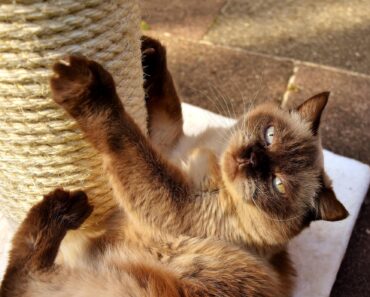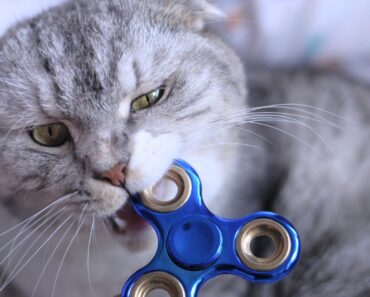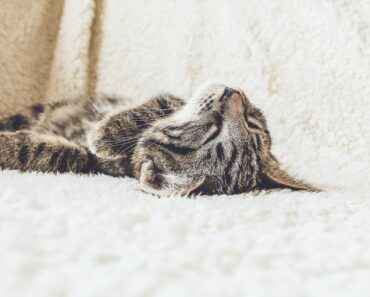
A pet that is surrounded by love and care rarely shows aggression. Any outbursts of anger that do occur always have a cause, and therefore can be corrected. Frequent, uncontrolled attacks can result in serious injury. Therefore, the problem should be treated as soon as it occurs.
Why does a house cat attack and bite its owner?
In most cases, the aggression is psychological in origin. The animal is driven to this behavior by a wide range of emotions. If there is no pathology, a disgruntled cat will always warn you of a possible attack:
- flattening his ears, pulling them back;
- arching his tail and back;
- lifts its fur along the spine;
- turns sideways towards the enemy;
- makes hissing or growling noises.
If you notice such behavior, leave him alone and carefully analyze what caused it. Eliminating the irritant will help you avoid further outbursts.
Illness or pain
If a previously gentle cat becomes aggressive and attacks its owner, this behavior may be caused by pain. A paw that has been injured in a bad landing will react to the slightest touch, even the most gentle. An animal may pounce to avoid contact with an injured limb.
The pain syndrome is not only characteristic of injuries, but also of certain diseases: , , oral pathologies. Observe carefully the accompanying symptoms. In case of apathy, sleep disorders, it is best to have it checked at the veterinary clinic.
Another possible cause of the crisis is the alteration or total loss of the function of one of the senses. Disorders of hearing, vision and smell disrupt normal perception and distort the defense function. This problem most often occurs in old age.
Bad education
Frequent play with human hands becomes a habit. As the kitten grows, its claws become longer and sharper. The damage caused by these “cold weapons” is much more severe than in childhood. The mustachioed lover, accustomed to the lack of punishment, will not only play with your hands, but will also take it out on them.
If a cat doesn’t like to sit in the arms of strangers, it will easily get its claws into anyone who dares to touch it. This behavior will be especially dangerous if a small child is learning the world through touch.
Self-defense
Claws and teeth are not only used to attack, but also to defend themselves. Aggressive behavior is due to habitual fright. A sudden awakening, a sudden grip or a forceful grip of the cat is perceived as a threat. Most often, cats simply hiss and run away in hopes of hiding in a hiding place. If all escape routes are blocked, they will fight to the death.
Protection of the offspring should also be noted. During pregnancy and lactation, the animal becomes more wary. She may bite a stranger or an animal that decides to disturb her kittens.
Demanding
Another unpleasant consequence of bad breeding is demanding behavior by biting. A cat may beg for food or play with its owner’s nibbles. More often than not, poorly trained pets will bite a person’s legs, pushing them in the right direction. Ignoring this behavior will not solve the problem, but will only increase the force of the bite.
Psychological trauma
A protective reflex is triggered not only by an actual threat, but also by a perceived threat. Animals removed from the street often suffer from psychological trauma caused by wandering. Experienced memories, which trigger inappropriate behaviour, return when they see certain objects, sounds or smells. In these cases, the resulting aggression is called redirected aggression.
The more frightening the experience of violence, the more aggressive the eventual attack. An animal that is regularly beaten with a slipper can leave serious injuries to the owner who puts the shoes in front of the animal.
It is not only the abuse that causes stress, but also the excessive petting. If its privacy is frequently violated, the cat will begin to claim its freedom.
If your whiskered cat is well cared for and you provide privacy, take a moment to reflect on what has happened recently. He may have been stressed by a move, a baby or another pet. If this is the case, it’s all about getting the owner’s attention.
Competition with other animals
If a cat attacks another, it may be a competitor: it may be jealous of its owner or afraid of losing its territory. Keeping several pets together is not an easy task. Reconciliation between two mustached warriors will take time.
It is advisable to avoid direct intervention in these situations, as the pet’s aggression will be redirected to the owner. Wait until both animals have calmed down and are ready to cooperate before rearing them.
Cases of critical aggression
In addition to the situations mentioned above, uncontrolled aggression is also possible. Medical intervention is needed to stop it. Otherwise, an animal that is in an irrational state can cause fatal injuries to humans.
Sexual dissatisfaction
Neglect and lack of attention can lead to serious problems in the future. The unsatisfied sexual instinct does not disappear over the years, but builds up constantly. As a result, the accumulated energy is redirected in a negative direction in mid to late life. Behavioral problems appear, accompanied by increased nervousness and aggressive outbursts.
The cat has gone mad – literally
Feline insanity is a rare phenomenon in veterinary medicine. In 99% of cases, aggression is related to psychological trauma, poor parenting, self-protection or pain. Mental illness can only be determined by laboratory diagnosis.
If a pet is jumping out at your home, make an appointment with your veterinarian. If there are no abnormalities and the pet’s mental state is stable, he or she may need to see an animal psychologist.
What an owner should do if a cat bites and attacks
Understanding what to do if a cat attacks its owner can be determined by the cause of the aggression. The problem can be solved by education or treatment.
Educate
Regardless of the cause of the cat’s inappropriate behavior, retaliation by the owner will not be tolerated. The best response to an animal is to be ignored. If an attack occurs during a play session, leave the room and do not make contact with the cat until it understands its mistake.
Training should begin as soon as the whiskered cat arrives home. If the moment is missed, more time is needed. Adults have a harder time breaking established habits than kittens.
The following guidelines are helpful in rehabilitating a cat:
- Don’t get upset when another conflict arises. Gently remove your hand when the grip loosens and leave the room immediately.
- Use a spray gun. A water spray is ideal for preventing unwanted action.
- Get another animal. If the aggression is due to lack of attention, an extra playmate should solve the problem quickly.
Be patient. Your efforts will pay off over time.
Treat
If detected, the problem is corrected when the problem is cured. Prolonged and frequent attacks suggest a visit to the veterinarian.
A cat whose sexual instinct is not satisfied will need to be neutered. Psychological illnesses require extensive medication, but rabies cannot be cured. The patient will need to be isolated in a special box to confirm or deny the disease. A positive prognosis is only possible with vaccination against the virus.
How to reduce the risk of aggression?
A loving pet can only grow up in a caring and loving family. Never use physical punishment under any circumstances. Your hands should only be associated with affection.
Try to talk to your pet often and get to know its habits. Don’t test its patience if it gets upset and stop the nuisance immediately.
If the cat grows up around the child, make sure the child knows how to handle it gently. Prevent any sudden grasping or squeezing.
The arrival of a new family member should be done thoughtfully. Even with the representatives mentioned, you can find a way to deal with them if you respect their wishes as well as your own.
Cat bites and scratches take time to heal, which opens the door to pathogens. Attacks on animals must be nipped in the bud at an early age to prevent bad behavior from becoming a habit.
The cause of sudden seizures, which are not typical of a whiskered animal, should be checked immediately by the veterinarian. This will allow the problem to be caught early and treated before it gets worse.
This article is for informational purposes only. Contact your veterinarian!






